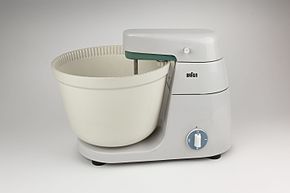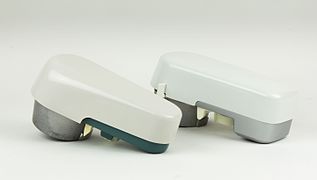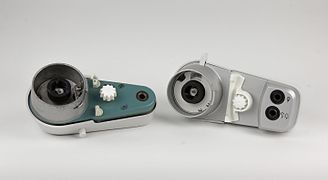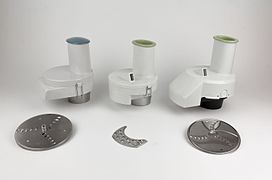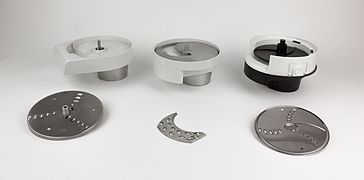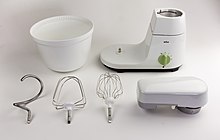Brown KM 3
The Braun KM 3 or Braun KM 32 is a kitchen machine ("food processor") developed by Braun GmbH , which was on the market from 1957 to 1991 and was produced in quantities of over 2.3 million. It is considered to be the model that coined the newly created term “kitchen machine” and is one of the most durable and most copied industrial products. As a prime example of German, timeless design, it is part of the inventory of museums such as B. the MoMA and the Museum for Applied Art in Cologne.
development
History and market situation
The first mixers with stands and bowls came on the market in 1920 - around 1930 in Germany. The first devices came from Kitchen Aid , later followed by the Mixmaster from Sunbeam . Braun began developing its own kitchen appliances in 1948, which were initially based on models from the US market. The first was the Multimix mixer and chopper from 1950, which was further developed with extensions to form a system with several functions. Artur Braun remembered his father Max Braun's instructions to produce the Multimix at half the price of the American models, which was almost achieved with a retail price of DM 129.
Development of the KM 3
1956 began with the development of a new, compact kitchen machine, which should replace the Multimix . At the center of the technical development was Artur Braun's idea of driving the mixing bowl from the edge. On this basis, tests were first carried out with separate drives for the bowl and agitator in order to determine their optimal speeds. Under constructor Günther Falkenbach, parallel to the shaping work in the design department, a first functional model was created that followed this principle, which was later patented. The industrial designer Gerd A. Müller , under the direction of Fritz Eichler, developed the final smooth and compact shape of the device on the basis of wooden and plaster models.
The KM 3 model (white with blue accent color) came onto the market in April 1957.
In 1961/62, Bodo Fütterer revised the kitchen machine technically, the design update of the model then known as KM 32 (1964–1991) was again made by Gerd A. Müller and Robert Oberheim. In this version, the machine was produced almost unchanged until 1991.
The most noticeable difference in the development of the food processor is the color change between the KM 3 (blue) and the KM 32 (green). Some details have seen other major or minor changes over the years:
- The control button of the KM 3 has three fixed levels that can be switched in 90 ° steps. On the KM 32, the scale has been shortened to a total of 90 ° for all three levels and a momentary switch has been added for short-term operation. There are device variants with or without a thermal switch or glow lamp on the switch button.
- The agitator arm, colored blue on the underside of the KM 3, only had one socket for the agitator tools. The KM 32 shows a central design deviation from the KM3: Instead of one opening for two tools, two openings for the tools have now been accommodated with different ratios, which necessitated a change in the shape of the head and thus made the whole machine appear bulky. Instead of a button for locking on the front, the KM 32 has a slide switch on the side. In 1983 there was a change to the connection sockets for the agitator arm in order to connect an additional whisk.
- Development stage of the agitator arm KM 3 - KM 32
- The Schnitzelwerke changed their design and the type of tool inserts several times. The tool disks themselves are either circular or sickle-shaped and, depending on the version, can be used with or without a carrier disk for the tools. The most noticeable differences in the latest, higher version by Hartwig Kahlcke (KS 33) from 1985 are the black plastic base and the different positioning of the carrier and tool washer. A plastic button is now used to open the attachment, while two metal clips take over this task on the older models. The shape and size of the discharge chute have also been changed.
- Stages of development of the Schnitzelwerk
Type designations
The following type designations and production years are recorded in overviews from 1989 and 1990:
| Type | designation | No. | colour | year | Designer | |
|---|---|---|---|---|---|---|

|
KM 3/31 | Kitchen machine basic equipment with mixer arm, kneading mechanism, large and small mixing bowl, whisk and dough hook. | 4203/4206 | White blue | 1957 | Gerd A. Müller |

|
Schnitzel factory 1 (without bean feed chute) | 1957 | Gerd A. Müller | |||
| Schnitzelwerk 2 (with bean filling chute) | ||||||

|
MX | Blender attachment | ||||
| KGZ | meat grinder | |||||
| KM 3Z | Citrus press | |||||
| coffee grinder | ||||||
| further accessories:
Cookbook, scraper, stand for discs, protective cover |
||||||
| KM 32 | Stand mixer basic equipment | 4122 | white / green | 1964 (other sources: 1961/62 ) |
Gerd A. Müller , Robert Oberheim | |

|
KS 32 | Schnitzelwerk | 4613 | |||

|
KX 32 | Blender attachment | 4614 | |||
| KGZ 2 | meat grinder | 4610 | ||||
| KMZ 3 | Citrus press | 4612 | ||||
| MXK 3 | coffee grinder | 4615 | ||||

|
KM 32 B | Kitchen machine basic equipment with large mixing bowl, dough hook, whisk and whisk. | 4209 | white / green | 7/1984 | |

|
KS 33 | Schnitzelwerk | 4247 | 1985 | Hartwig Kahlcke |
Price development
The so-called large basic equipment with stirrer and kneading mechanism, schnitzel mechanism, mixer attachment and a recipe book was offered in 1957/1958 at a price of 230 DM. In 1960 it cost 245, - DM, 1965 as KM 32 298, - DM, in 1972 365, - DM and 1989 469, - DM.
Components, function and design
The machine, which is almost entirely made of white duroplast , is built according to the stacking principle, in which the motor, gearbox and attachments are built on each other, clearly separated by a joint, and thus form a closed, very simple shape. In contrast to the phono combination SK 4 ("Snow White's Coffin "), which appeared a year earlier, the machine is characterized by flowing, organic shapes with Scandinavian echoes, thus expanding the company's design language that had been developed up to that point. The parting line in the motor base serves both as a ventilation opening and as a holder for the stop pin of the smaller mixing bowl.
The agitator arm or agitator head is removed with a handle, unlike with kitchen machines from other manufacturers, where the agitator arm is folded.
The bowl made of impact-resistant plastic and the housing nestle in a “parabolic curve” and form a harmonious unit. The use of the color for some elements serves to mark the operating process - at the main switch, on the underside of the mixer arm (only KM 3), the stoppers of the stand mixer and the schnitzel. The simple shape with no unnecessary decoration is easy to clean and offers little space for dirt to accumulate.
"Only two control buttons can be found on the otherwise Madonna-like outer skin, the immaculate surfaces of which make it clear that the machine is» washable «, one of the signal words of those days."
When assembled as a mixer, the KM 32 has the dimensions 26.7 × 36.8 × 19 cm, the bowl has a diameter of 24.1 cm, a height of 16.8 cm and a volume of 4.5 liters. The dough hook is 17 cm long, the whisk 16.8 cm.
Basic device with stirring function and bowl
The motor base of the food processor with toggle, internal electrical system and motor merges seamlessly into the base plate with a metal bearing pin, on which the mixing bowl is placed with a central recess. At the upper inner edge the bowl has a toothed ring in which the attached gear head engages with a drive pinion , so that the bowl is driven from the edge.
The gear head, which is locked with a bolt (KM 3) or a clamping lever (KM 32) on the motor base, accepts the stirring tools (dough hook , whisk , whisk ) via the drive socket (s) . During operation, the agitator works like a planet, rotating in the opposite direction to the bowl.
The motor, which develops a considerable volume, can be controlled with the colored toggle switch to the right in three locking power levels; to the left, from model KM 32 onwards, full power can be achieved briefly in a momentary switch.
Blender
Instead of the gear head, a stand mixer with a conical base is placed on the motor base. The knife insert is placed on the metal base with a red sealing ring and this is then screwed to the mixing bowl made of temperature-resistant, thick-walled glass. The funnel-shaped white plastic lid of the mixer glass with graduations is closed with a stopper made of colored plastic.
Schnitzelwerk
The dismountable Schnitzelwerk attachment for planing, cutting and chipping consists of the gear part, which is placed on the motor base, plus several tool disks or inserts (cutting insert, grater insert and friction disk) and the cover. This has one or - from Schnitzelwerk 2 - two openings at the top: a large filler neck, where the food to be chopped is fed to processing with a stopper (highlighted in color), and a small bean filler chute.
Technical specifications
The following performance data are given in the service documentation from 1984 for the KM 32:
| Voltage frequency | 110 V / 120 V, 40-50 Hz |
| Power (no load) | Level 1: approx. 125 W + 10%
Level 2: approx. 130 W + 10% Level 3 / momentary switch: approx. 205 W + 10% |
| Primary speed (no load) | Step 1: about 10700 min -1
Step 2: ca. 12,500 min -1 Stage 3 / momentary switches: 16000 min -1 |
| Overheating protection | Thermal switch / fuse |
| Cable length | approx. 1.30 m |
| Operating time | Continuous operation at 400 W. |
Depending on the series, agitator tools and drive bushings, different idle speeds are achieved on the agitator arm:
| A motor | B engine | |||
|---|---|---|---|---|
| Kneading socket | Stirring sleeve | Kneading socket | Stirring sleeve | |
| step 1 | 461 | 184 | 388 | 155 |
| Level 2 | 539 | 216 | 517 | 207 |
| Level 3 / momentary switch | 690 | 276 | 603 | 241 |
History of impact / reception
At Interbau 1957, various model apartments were fitted with the KM 3 and other Braun devices. In the same year, the eight Braun GmbH products on display were awarded the Grand Prix at the eleventh Triennale in Milan , including the KM 3. In the German pavilion at the 1958 World Exhibition in Brussels, there were a total of 16 different Braun appliances from various sectors - including the food processor -, which were gathered as "particularly high-quality products of industrial and handicraft production".
In 1958, the New York Museum of Modern Art showed an exhibition on outstanding design in the 20th century , including the KM 3 and four other Braun products, which were then included in the permanent design exhibition . Today a KM 32 with the inventory number 561.1964.ae) belongs to the Architecture and Art department of MoMa. In the Museum of Applied Art Cologne they also part of the inventory.
According to the authors Polster and Meyer, the Braun KM 3 was the kitchen machine that first coined the term and made all previous models "look clumsy". For collector and author Hartmut Jatzke-Wigand, it sets a use value standard, i. H. it "defines its [...] product division through innovative technology and innovative design." For Jonathan M. Woodham, Director of the Design History Research Center at the University of Brighton, it is "the epitome of the geometric clarity that one is for to associate with Braun products for many more years ”.
KM 3 and KM 32 are traded used up to the present day. In 2015, design and art historian Klaus Klemp was convinced that the almost four decades of almost unchanged KM 3, equipped with the latest technology, would make all competitors in the kitchen look “monstrous”. This is all the more remarkable as the design of technical devices has a very short half-life.
A so-called “Tribute Collection” with various appliances, some design elements reminiscent of the KM3 / KM32 and other kitchen appliances from the era, was launched in 2014 by De'Longhi , the current Braun brand owner for kitchen appliances and small household appliances .
Web links
- Braun KM 32 Service Documentation Market Release 7/84. (Parts list of the KM 32 with exploded drawings, circuit diagrams and repair instructions)
Individual evidence
- ↑ a b c d Artur Braun : From engineering draft to product design: the development of the Braun kitchen appliances and the 'KM 3' kitchen machine . In: Hartmut Jatzke-Wigand, Jo Klatt (ed.): Design + Design Zero. How the Braun design came about. 3. Edition. Jo Klatt Design + Design Verlag, 2011, ISBN 978-3-9811106-4-7 , p. 48–55 ( designundtext.com [PDF; 76.5 MB ; accessed on June 28, 2020] final issue of the magazine).
- ↑ a b c d e Bernd Polster , Olaf Meyer: Braun. 50 years of product innovations . 2nd edition 2012. DuMont Buchverlag, Cologne 2012, ISBN 978-3-8321-7364-7 , pp. 376-379 .
- ↑ a b c MoMA Collections: Gerd Alfred Müller, Robert Oberheim. Kitchen Machine (model KM 32) 1957. In: https://www.moma.org/ . MoMA, accessed November 10, 2016 .
- ^ A b Günter Staeffler: Form-stable. Kitchen machine KM3 / K32 . In: Jo Klatt (Ed.): Braun + Design. Independent magazine for design collectors . No. 13 . Hamburg 1989, p. 4 .
- ↑ a b c Braun - Success with new devices . Advertising brochure. Max Braun, Frankfurt 1958, p. 4-5 .
- ↑ a b c d e Hartmut Jatzke-Wigand: The development of the Braun design up to 1965 - an exemplary product selection . In: Hartmut Jatzke-Wigand, Jo Klatt (ed.): Design + Design Zero. How the Braun design came about. 3. Edition. Jo Klatt Design + Design Verlag, Hamburg 2011, ISBN 978-3-9811106-4-7 , p. 110–130 , here 119-121 ( designundtext.com [PDF; 76.5 MB ; accessed on June 28, 2020] final issue of the magazine).
- ^ A b Günter Staeffler: Form-stable. Kitchen machine KM3 / K32 . In: Jo Klatt (Ed.): Braun + Design. Independent magazine for design collectors . No. 13 . Hamburg 1989, p. 14/15 .
- ^ Jo Klatt: Braun + Design Collection . Braun products from 1955 until today. Ed .: Jo Klatt, Günter Staeffler. Hamburg 1990, p. 220 .
- ^ Braun GmbH (Ed.): Braun KM 32 Service Documentation . S. 1 ( PDF document ).
- ^ Günter Staeffler: Form-stable. Kitchen machine KM3 / K32 . In: Jo Klatt (Ed.): Braun + Design. Independent magazine for design collectors . No. 13 . Hamburg 1989, p. 6 .
- ↑ a b Joachim Schirrmacher: From glues, crumbs and kneaders. Test kitchen machines. In: www.joachim-schirrmacher.de. May 10, 2015, accessed on November 12, 2016 (First published in abbreviated form: Von Kleber, Krume und Knetern. NZZ on Sunday, May 10, 2015, pages 24 - 25).
- ^ Günter Staeffler: Form-stable. Kitchen machine KM3 / K32 . In: Jo Klatt (Ed.): Braun + Design. Independent magazine for design collectors . No. 13 . Hamburg 1989, p. 7 .
- ^ Braun GmbH (Ed.): Braun KM 32 Service Documentation . 1984, p. 6 ( PDF document ).
- ^ Braun GmbH (Ed.): Braun KM 32 Service Documentation . 1984, p. 15 ( PDF document ).
- ^ Museum of Modern Art shows electrical appliances from Max Braun oHG, based in Frankfurt am Main, December 17, 1958. Contemporary history in Hesse. (As of December 17, 2013). In: Landesgeschichtliches Informationssystem Hessen (LAGIS).
- ↑ Sophie Lovell et al. a .: Dieter Rams: As little design as possible . Phaidon, Hamburg / London 2013, ISBN 978-3-8419-0190-3 .
- ↑ Oral testimony by the curator for design at MAKK , Gabriele Lueg
- ↑ Jonathan M. Woodham: Twentieth Century Design . In: Oxford History of Art . tape 5 . OUP Oxford, Oxford 1997, ISBN 978-0-19-284204-6 , pp. 155 : "A design department was established at the company in 1956, the KM3 of the following year epitomizing the geometric clarity which was to be associated with Braun products for many years, [...]"
- ↑ Klaus Klemp : Good design is honest . In: Philipp von und zu Liechtenstein (ed.): Credo. LGT Journal on Wealth Culture. Honesty . No. 20 , 2015, p. 23 ( PDF document ): “And if the Braun KM 3 food processor - whose form remained virtually unaltered over some four decades - were revived today, equipped with up-to-date technology, it would make all its modern competitors in the kitchen look monstrous in comparison. This is more than remarkable, because technical equipment is an area where design usually only has a short half-life. "
- ↑ Thomas Edelmann: Yesterday's Visions. In: stylepark.com. April 13, 2014, accessed July 15, 2018 .
